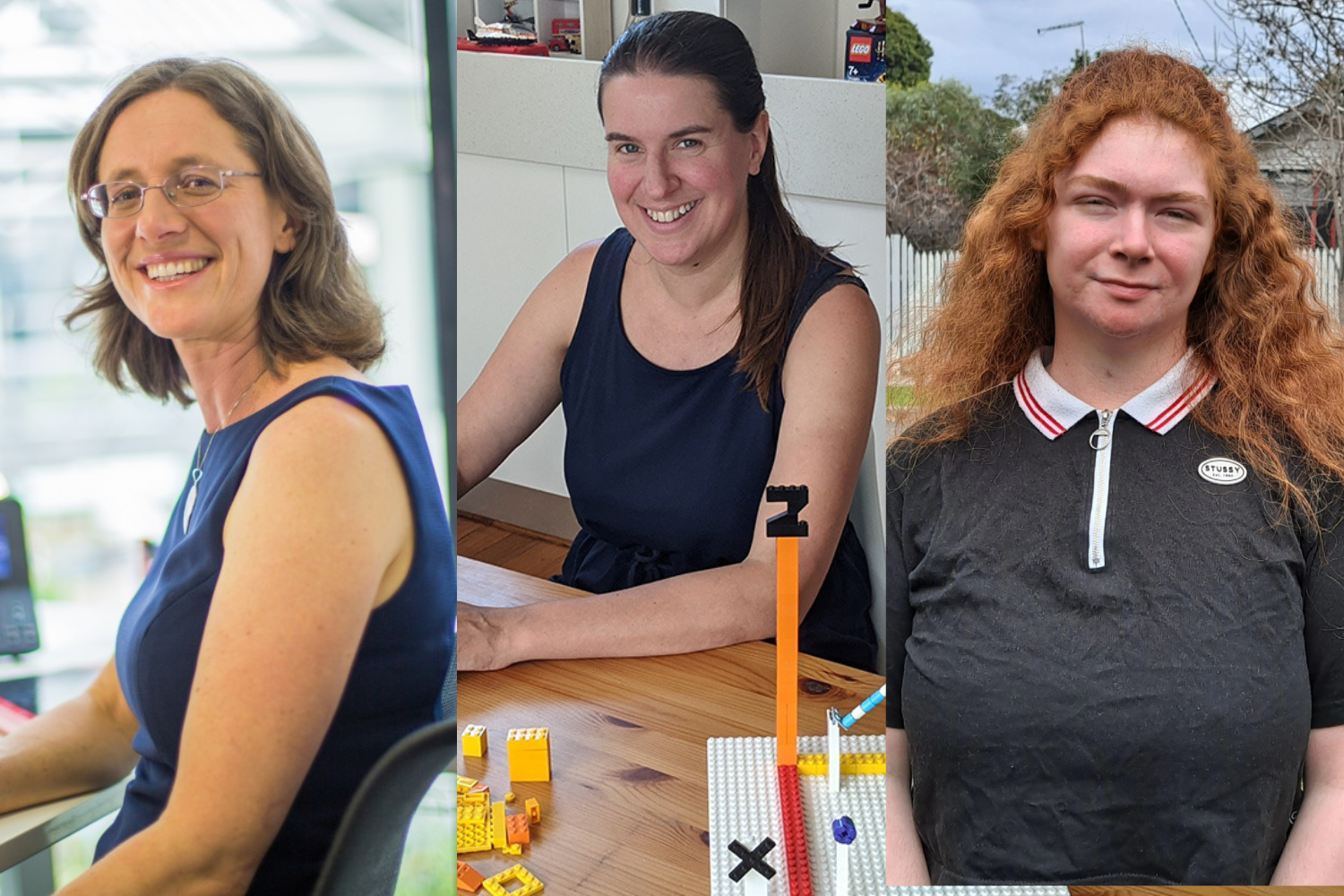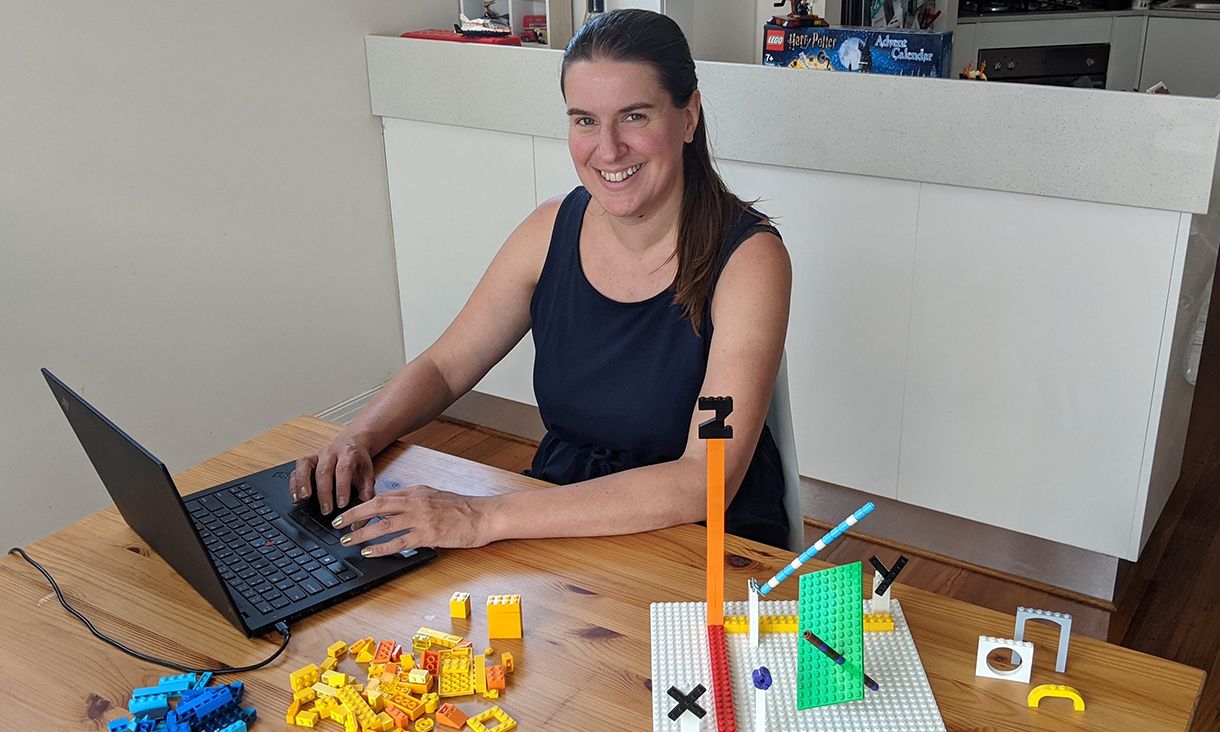Chief Scientist celebrates women in maths

Some of the amazing Swinburne academics and graduates who are making their mark on the world with maths. From left to right: Dr Louise Olsen-Kettle, Dr Emily Cook and Holly Casey
In summary
- Swinburne Senior Lecturer in STEM Education Dr Emily Cook has been creating LEGO stop-motion animation videos to help students solve math problems
- Vice Chancellor’s Women in STEM Fellow in Mathematics at Swinburne, Dr Louise Olsen-Kettle, uses mathematical modelling of damage to create longer-lasting products
- Graduate Holly Casey is using her programming and mathematical modelling skills at the Australian Energy Market Operator
While girls outnumber and outperform boys in many top VCE subjects, a recent analysis has shown that boys are still outnumbering girls in specialist maths and mathematical methods.
Women in Maths Day on May 12 is an opportunity to celebrate women’s achievements in mathematics and inspire the next generation to embrace and find their passion for this crucial subject.
Swinburne Chief Scientist Professor Virginia Kilborn says that mathematics is essential to solving the major problems facing humanity, from climate change and environmental management to health, medical technology and beyond.
“Even though girls who take subjects in maths and science often outperform the boys, negative stereotypes and a lack of role models means that the number of girls choosing these subjects continue to decline,” says Professor Kilborn.
“This is despite the fact that maths skills are incredibly in demand across a range of industries and play a crucial role in advances in all manner of innovative technologies.”
“We need to not only raise the level of mathematics across the board, but also ensure that women and traditionally underrepresented groups are attaining the highest level of mathematics to help contribute to the ground-breaking solutions of the future.”
Professor Kilborn highlights some of the amazing Swinburne academics and graduates who are making their mark on world with maths.

Dr Emily Cook
Swinburne Senior Lecturer in STEM Education Dr Emily Cook has been creating LEGO stop-motion animation videos to help students solve math problems.
The pun-filled animations address short problems that are difficult to teach online, as well as long-form questions that require physical models to demonstrate. Her most recent videos include complex numbers (with a mummy) and vector cross products (with an elephant).
As a woman in STEM, Dr Cook says it can be “uncomfortable” being the only woman in the room sometimes and says there are times that she feels like she needs to prove herself. However, it also gives her the opportunity to inspire other women interested in a career in STEM.
She encourages anyone looking to pursue a career in STEM, especially women, to “just go for it”.
“Maths is important as it is used every day, whether or not people realise they are consciously using it. It underpins so many academic courses and careers from science and engineering, to business and design,” Dr Cook says.
Her best advice? “Do what you enjoy and believe in yourself,” she says.

Dr Louise Olsen-Kettle
Dr Olsen-Kettle is a Vice Chancellor’s Women in STEM Fellow in Mathematics at Swinburne and was recently awarded a Victorian Endowment for Science Knowledge and Innovation (VESKI) Inspiring Women Career Recovery Grant.
Dr Olsen-Kettle’s work is in mathematical modelling of damage to create longer-lasting products, forecast risk and prevent structural disasters such as bridge or building collapses. Her VESKI grant is supporting her work as part of Swinburne’s flagship Space and Aerospace Technology research work by creating stronger and more resilient 3D-printed parts through numerical simulation.
“Producing stronger and more resilient 3D-printed products will allow the Australian manufacturing, automotive, aviation and defence industries to fully exploit all that additive manufacturing technology has to offer,” Dr Olsen-Kettle says.
Louise has volunteered for over 10 years through various school engagement programs to inspire students to study science and champion girls in STEM, including the CSIRO STEM professionals in school, BrainSTEM and AMSI ChooseMaths mentoring programs, and as a tutor in programs to assist refugee students.

Holly Casey
Holly Casey studied a Bachelor of Science at Swinburne, majoring in Applied Mathematics and Physics. She has recently started in a graduate position at the Australian Energy Market Operator, which manages electricity and gas systems and markets across Australia.
Not only does her physics knowledge help her navigate the energy industry, she is using her programming and mathematical modelling skills every day. But she says the real edge that maths gives her is in problem solving.

“Maths gives you an understanding of the world that nothing else quite does,” she says. “It’s hard to quantify but it allows you to approach these impossible problems and find solutions.”
She says that it can sometimes be lonely in maths and physics classrooms, especially when there are less women in the class, but that maths has helped transform the way she thinks.
Her best advice for students is to find people around you to support you so you can build the confidence to push through the challenges that maths and science degrees often throw at you.
“I wish I’d had more female supervisors and mentors,” she says. “My advice is to jump into as many networks as you can, especially with women who have done what you are doing now.”
-
Media Enquiries
Related articles
-

- Technology
- Science
- Engineering
Victorian students drive green energy transition through international hydrogen competition
Swinburne’s KIOSC, in collaboration with Horizon Educational and Gippsland Tech School, co-hosted the Hydrogen Grand Prix in Melbourne.Friday 26 July 2024 -

- Science
Skin, scales and fish tails: using collagen to turn fish guts into gold
New research from Swinburne could transform the sector by converting high value collagen proteins from seafood by-products into cosmetics, food, and pharmaceuticals.
Tuesday 02 July 2024 -

- Science
- Engineering
Submarines in the future could self-identify cracks and self-heal thanks to Swinburne researcher
Thanks to the work of Dr Nisa Salim from Swinburne University of Technology’s School of Engineering, future submarines could self-identify microcracks and self-heal using a new kind of carbon fibre reinforced polymer composites.
Monday 17 June 2024 -

- Science
Inaugural Swinburne-CSIRO Indigenous Research Fellow joins national water quality forecasting project
Swinburne University of Technology has appointed spatial ecologist Associate Professor Sally Waller as its inaugural Swinburne-CSIRO Indigenous Research Fellow...
Thursday 13 June 2024 -

- Social Affairs
- Health
Swinburne leads world-first medical cannabis driving trial
Swinburne researchers are spearheading a world-first trial to evaluate whether patients can drive safely while on prescribed medical cannabis
Tuesday 28 May 2024

